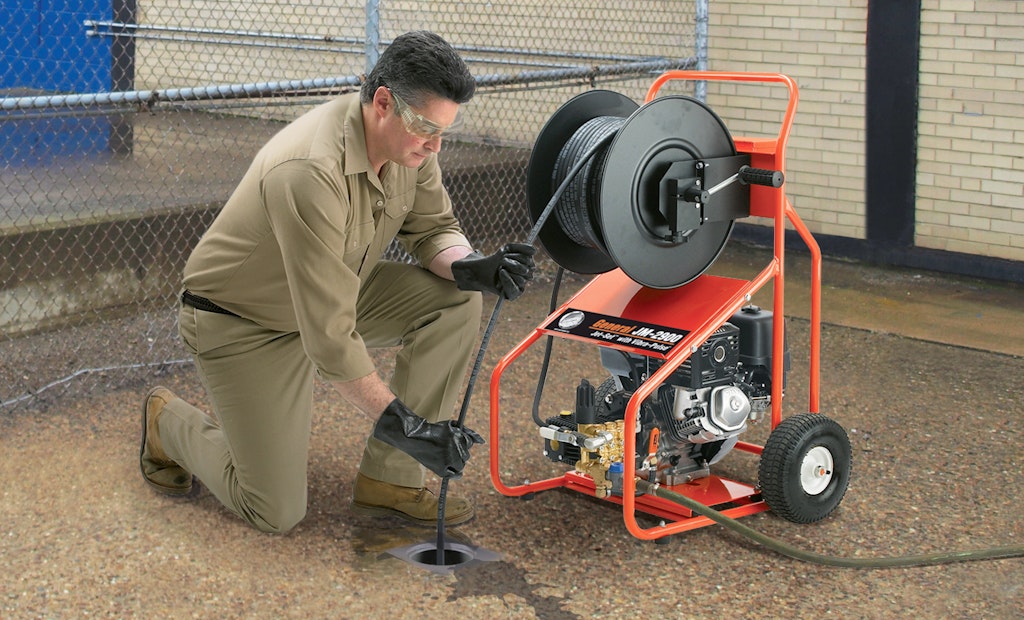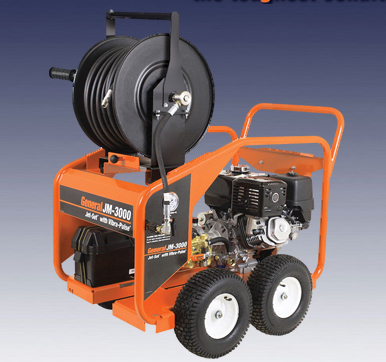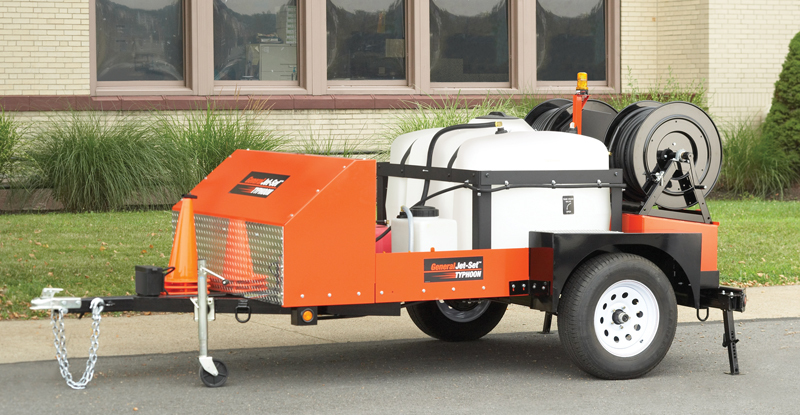High-pressure water cleaning systems have become the tool of choice for many drain cleaning professionals because of their effectiveness in dealing with grease and sludge, along with their ability to partner with pipe inspection cameras. From mini-jets that specialize in cleaning kitchen sink lines to jumbo-sized trailer units able to scour 18-inch mains, these tools have hit the mainstream of service plumbing. However, before you fire up your jetter and go off to battle underground clog monsters, there are six things to keep in mind.
1. What the heck is down there?
Jetters do a great job on soft stoppages like grease, sand, sludge and even ice. However, when it comes to roots, they are not the preferred tool for the job. If you’re not sure what is happening in the drain, you can try to send an inspection camera down to take a look, but if the drain is blocked you won’t be able to see much. Remember, cameras can’t see underwater any better than you can. So how can you tell what the blockage is?
First, if the drain in question has anything to do with food service, there is a better than even chance that grease is the culprit. These days, there’s more and more grease circling the drain in someone’s kitchen sink, and too much of it isn’t completing the journey all the way to the municipal main drain. Using your powers of deduction you can conclude that clogs in drains leading from restaurants, multifamily dwellings and any kind of institution involving food service are likely to be made of grease. The same will be true if the pipe in question originates in a factory or industrial facility that flushes lubricants, solvents or any type of organic material down the drain. Also, depending on where in the world you are, sand can be a persistent problem. However, if your first guess is a root incursion, we recommend that you begin with a good old-fashioned cable drain cleaning machine, and follow up with a jetter, and then a pipe inspection system. If you jet the line after going through with a snake, you’ll be amazed at how much more there is to see.
2. Shake, rattle and roll.
Does your jetter unit have a way to vibrate the hose while it’s in the pipe? At General, we call this feature Vibra-Pulse, and its function is to break up the surface friction between the hose and the pipe so that you don't get stuck. One of the first things that contractors noticed when they invented jetting machines 35 or 40 years ago was that when you connect a hydraulic hose and rear facing nozzle to a pressure washer and shove it down a drain, there is a chance of getting the hose stuck in the pipe. And anytime that happens it's the beginning of a long day because you’re going to need an excavator to get it out. That's why every legitimate manufacturer of high-pressure jetters in the world today has a feature that allows you to vibrate the hose while in use. So if you've purchased your jetter from a company that specializes in drain cleaning, you're in luck. On the other hand, if you’ve simply attached a drain cleaning hose and nozzle to your pressure washer, get ready for a long day. We suggest you pack a lunch and keep that excavator handy.
3. Yes, size matters.
Are you using the correct size hose for the pipe that you are trying to clear? Another excellent way of getting your hose stuck in the pipe is by using the wrong size, which is surprisingly easy to do. When working with high-pressure water, the philosophy is to use the largest hose that will fit down the drain. This is because hoses with a larger inside diameter don’t have as much pressure loss due to water friction. For example, the friction loss in 1/4-inch I.D. hose with 4 gpm flow is 360 psi for every 100 feet. If you use a 3/8-inch I.D. hose in the same situation, the pressure loss would be only 50 psi. All things being equal, the larger the hose, the more pressure at the nozzle. The more pressure you have at the nozzle the easier it is to do the job.
However, remember that there is a balance between size and flexibility. Generally speaking, bigger, thicker hoses tend to be less flexible and smaller, thinner hoses tend to be more flexible. If you decide to use a larger hose in a small pipe in order to reap the benefits of higher PSI at the nozzle, make sure you don’t go too far. If you use too large a hose, there is a chance that you will never reach the clog to do your work. Or worse, you will get the hose caught in the drain. (Refer back to point number two regarding long days, packed lunches and excavators.) Do your homework in order to coax the most out of your equipment.
4. Check your water.
Since high-pressure water is doing the work down the drain, it makes sense to make sure that you have enough of it. If you happen to be using a large device with a holding tank, such as a trailer jetter, your only challenge is to make sure that the tank doesn't run dry. Most of these units have an automatic shut-off that keeps you from making this mistake. However, if you are using a jetter that draws water from a garden hose, a little more attention is required. Most municipal and well water systems in North America will deliver approximately 5 to 6 gallons a minute of flow, but we recommend that you make no assumptions. Just get a 2-gallon bucket and measure how much time it takes to fill. If you’re close, don’t take the chance, because you could accidentally starve the pump of water and cause cavitation. Cavitation is the second most popular way to kill your pump, so pay attention to details.
5. It don’t mean a thing if you don’t have that swing.
Keep your hose moving. The preferred technique for jetting a line is to work the hose back and forth: push the hose 2 feet forward, then pull it back 1 foot, then push 2 feet forward, then pull 1 foot back. The maximum cleaning action comes when you are retracting the hose, not pushing it out. As you pull back, the angle of water flow exiting the nozzles scours the sides of the pipe, magnifying your cleaning efforts. If you keep the hose moving, you’ll do a better job and do it in less time.
There’s another reason to keep the hose moving. Because of the fluid dynamics of high-pressure water flow, turbulence can cause vortices to form just behind the nozzle when you’re doing a job. These vortices, if stationary for any length of time, can suck sand, loose dirt, grease or sludge in behind the nozzle, causing a plug that can trap your hose down the pipe. Getting your hose caught in the pipe, no matter what the cause, is a bad thing. (Again, refer to section two.) Unlike a snake that gets caught in the drain, you can’t just hook it to your bumper and pull it out. Digging is usually the only viable option.
6. Don’t freeze up.
Statistically, freezing is the number one way to kill your pump. Obviously, you are exempt from this warning if you live in a warm-weather state. However, if you live in a place with four seasons, you’ll find that it is surprisingly difficult to keep your pump from freezing when you are doing work on a frigid day. The damage can take place before, during and after the job, and can affect your hose as well as your pump. If your unit has an antifreeze tank (like General’s Typhoon trailer jetter), please get in the habit of using it whenever the temperature is close to freezing.
If your unit does not have this feature, introduce antifreeze into the pump (you may need to get a short hose and funnel) to keep it from freezing when you are driving to and from the job. Just disconnect the hose that runs from the output valve to the hose reel swivel. Then pour antifreeze into the inlet as you start the motor on your unit, which will draw the fluid through the pump. When you notice antifreeze exiting from the output valve, turn off the motor. Then, use an air compressor to blow any water out of the hose (take off the nozzle). Make sure that this has been done before you drive to the job, and again before you drive home. During the job, limit the amount of time the unit sits without water flowing through the pump. Turn the unit on frequently, running water through the bypass system to keep it warm. If you make it someone’s job to pay attention to the pump, then you’ll improve the odds of it surviving till spring.
You probably noticed that most of the points above could be summarized by “pay attention to what you’re doing” and “do your homework.” Jetters are fantastic tools for our industry, able to address most modern sewage problems better than other tools at our disposal. But, like everything else in life, greater power comes hand in hand with greater responsibility. If you sweat the details, a jetter is an incredibly versatile and profitable tool that can transform your business.
Any questions? Call the Drain Brains at 800-245-6200 or visit www.drainbrain.com.








